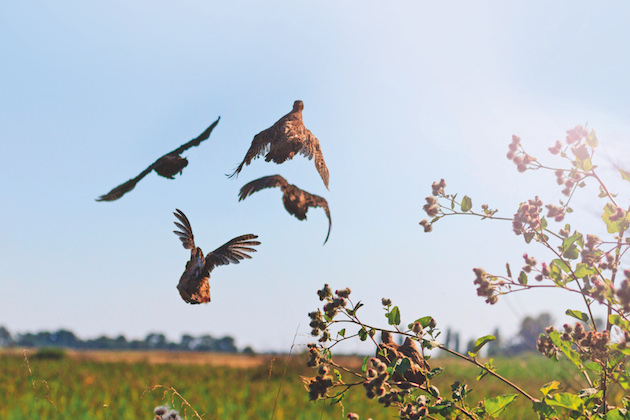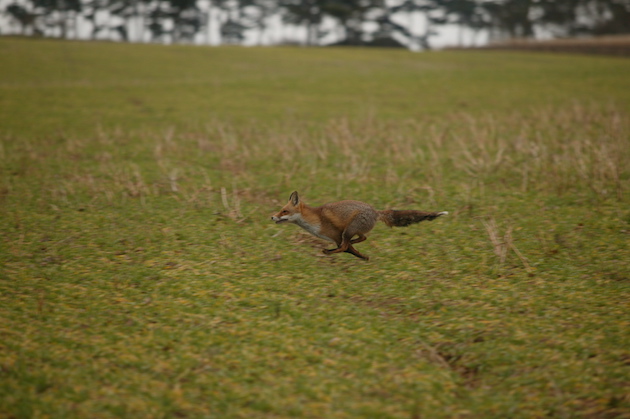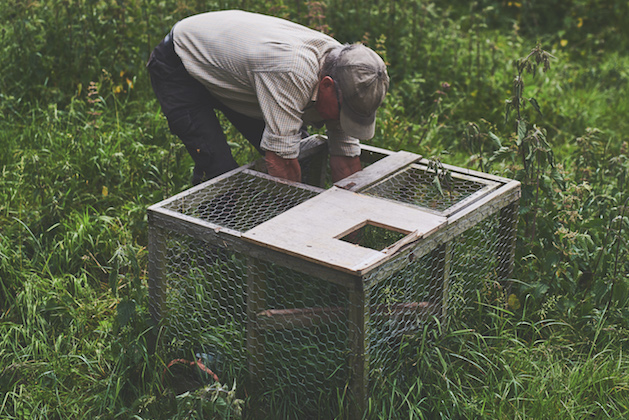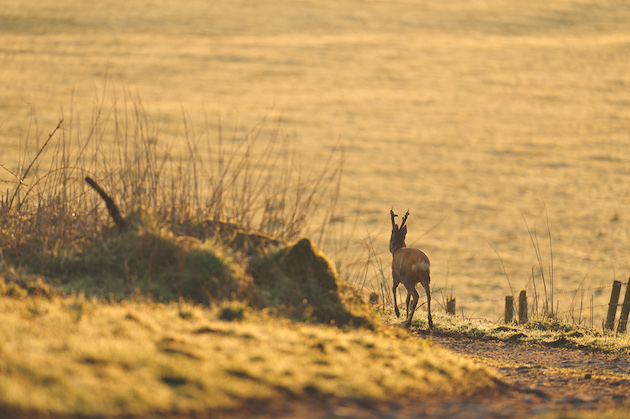Win CENS ProFlex DX5 earplugs worth £1,149 – enter here
Conservation in the age of coronavirus
 GEGYF3 flock of gray partridges flies from under the feet with sunny hotspot
GEGYF3 flock of gray partridges flies from under the feet with sunny hotspot
I write this at a time of uncertainty and trepidation for all. COVID-19 has utterly changed our lives in a few short weeks. What the ramifications will be, both financial and physical, in the medium to long-term are topics of much concern and speculation.
Those of us who live and work in the countryside should thank our lucky stars, for we are truly blessed. We fortunate few have not had to endure the tedium of four walls and 24-hour television suffered by those locked down in city tower blocks.
Our exercise is not one of an hour spent tripping around an urban park like social-distancing hamsters on a wheel. I drive my truck the few miles to Flea Barn and there I have worked and continue to work in my solitary world. My interactions are with my dog and the birds and beasts that live here. My only human companionship is provided by Flea Barn’s owner, Ed Nesling, as he passes by in his tractor or as a distant, cogitating form, walking his crops or looking for the grey partridges that have become an all-absorbing obsession of late.
Safe territory
For those of us who are working conservationists there are already obvious signs that the virus is having an impact on wildlife. Within a week I noted that the absence of road traffic was having an effect. Roe and muntjac were to be seen feeding nearer the road edge and at times of the day when they would more usually have been in cover.
As the traffic continued to decline, the paired-up partridges, grey or French, had taken to treating roadside verges as safe territory. Roadkill was becoming a rare sight.
Suffolk is a very rural county; we have no motorways, a mere two A roads and a laughable train service. Bus routes are so convoluted and erratic that it is said some commuters using the service have been dismissed for being days late for work rather than hours. So the car is essential and our narrow lanes, at peak hours, become busy thoroughfares.
Since the outbreak of COVID-19, however, the cadavers of hedgehogs, muntjac and badgers bloat, reek and decay at the lane’s edge no more. Sad clumps of feather and flesh no longer become road dressing. The lockdown has seen an end to drivers speeding down rural rat-runs. For now, no cocoons of Japanese or German tin casually plough down birds in the cause of getting to a meeting on time. However, while at first glance all this is a positive, there has been an unexpected outcome.

The GWCT has highlighted that fox control should carry on despite the coronavirus restrictions
Smorgasbord
The array of squished mammal and avian roadkill that was once the smorgasbord for carrion eaters is no more. Crows and magpies, rats and foxes dined on the dead in the road. Buzzards and kites and badgers feasted on the victims that had crawled or were thrown into fields. With this ready source of food now absent, the corvids in particular have had to head away from the roads and are now hunting the farmland.
At Flea Barn we have five Larsen traps in operation. Ed has kept notes of the catch over the years and this season has been a bumper haul. At the time of writing, 14 magpies and nine crows have already been caught — usually the tally is in the low 20s by the end of nesting season. Shooting restrictions have been put in place during the lockdown for pest controllers. Thus, with a dramatic rise in corvid numbers moving into prime nesting territory, it is essential that cage trapping continues.
This applies to both professional and amateur land managers. We started our corvid control early and hope that many of the residents, with their ‘prey memory’, may have been accounted for. The new arrivals’ beaks are no less dangerous, but they gape before a brain that lacks the local knowledge of their predecessors.
The quiet roads have also proved to be a positive for badgers and foxes. For badgers, March and April are busy. Amorous boars are on the prowl for sows. Pre-lockdown, many fell prey to cars. Females, disturbed by these testosterone-fuelled males, will move cubs to fresh setts. Cubs will make their first appearance above ground in April and the sows are busy feeding themselves and the weaning cubs.
I have already seen old setts, for years fallen into disuse, reopened. While the badger may be a totem for wildlife trusts and guitarists from 1970s rock bands, they are to those passionate about ground-nesting birds or bumblebee colonies a problem about which we can do nothing.
Foxes, meanwhile, are controllable. They, too, are reacting to decreased carrion by casting their attentions away from roads. Thankfully, the GWCT has already highlighted that fox control by gamekeepers should go on despite the restrictions caused by the coronavirus. Reports from keepers from north to south are that plenty of foxes are afoot and are being controlled as usual.

Larsen traps have been much busier than is usual at this time of year
Greatest threat
The Government has encouraged people to take their daily exercise in the countryside. Many footpaths that would usually rarely see a walker have become rediscovered delights for those released from their isolation. My great friend and superb naturalist gamekeeper Rod Hazell once told me that the greatest threat to wildlife was a couple wearing cagoules armed with a map and a cockerpoo.
I am sure that other breeds of dog and types of rainproof wear are equally deadly. It would be sage advice, during these strange times, for all landowners with footpaths to place friendly signs noting the fragility of nesting birds against the nose of a questing dog.
Insects seem to be faring remarkably well. The mild, wet winter was a major contributing factor and the spring weather has turned warm early. This has helped boost spring wildflowers, too. The other day, I sat and ate my lunch in the sunshine by a hedge I had laid alongside a cover. I noted the sheer volume of noise. A continual drone of bumblebees and hoverflies that were energised — feeding on the cowslips, primroses and violets.
The hum provided the bass to the woodwind of pigeon and the plovers that flashed in a pack over the plough. Skylarks, too high and too many to count, added high notes and so many finches and tits jabbered away in the scrub that their combined song became a string section. Percussion came from the pheasants and clamouring rooks. Not one aeroplane roared, no background hum of car, wail of siren or jarring horn. No human intervention bar the munching sound of my teeth on a pork pie.
COVID-19 has given us if not total silence, certainly complete peace. This farmed landscape, we are told by experts, is the epicentre of man’s destruction of the planet.
Scientists have opined, and millions have agreed, that our world teeters on a precipice. They claim much of this is caused by agriculture. The use of sprays, cows’ belching, muck spreading and released pheasants. Yet in a mere fortnight since lockdown, a time of grounded planes, foregone car journeys and shopping with thought, things have changed.
The insects have already increased, my sticky pads that I place in floral margins so that I can compare yearly data tell me so. Air quality has improved; nitrogen dioxide levels have dropped by 60% from the same point last year, according to the University of Birmingham. Noise pollution has become near non-existent. Farming, meanwhile, continues unchanged.

Roe deer are becoming much braver around roads and fewer are ending up as roadkill
Challenges
This terrible virus has taken, and sadly will continue to take, human lives. Businesses, be they connected with shooting or not, will be terribly impacted or even forced to close. It has presented new challenges for those of us who grow the food or care for the wildlife in the countryside. Yet the ongoing tasks in game and wildlife conservation continue.
Ed sowed a new perennial game cover block; I felled some trees to add light to the main cover. We must hope that our efforts for game will come to harvest once the crisis is over.
Related Articles
Get the latest news delivered direct to your door
Subscribe to Shooting Times & Country
Discover the ultimate companion for field sports enthusiasts with Shooting Times & Country Magazine, the UK’s leading weekly publication that has been at the forefront of shooting culture since 1882. Subscribers gain access to expert tips, comprehensive gear reviews, seasonal advice and a vibrant community of like-minded shooters.
Save on shop price when you subscribe with weekly issues featuring in-depth articles on gundog training, exclusive member offers and access to the digital back issue library. A Shooting Times & Country subscription is more than a magazine, don’t just read about the countryside; immerse yourself in its most authoritative and engaging publication.







